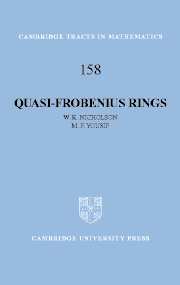Book contents
- Frontmatter
- Contents
- List of Symbols
- Preface
- 1 Background
- 2 Mininjective Rings
- 3 Semiperfect Mininjective Rings
- 4 Min-CS Rings
- 5 Principally Injective and FP Rings
- 6 Simple Injective and Dual Rings
- 7 FGF Rings
- 8 Johns Rings
- 9 A Generic Example
- A Morita Equivalence
- B Perfect, Semiperfect, and Semiregular Rings
- C The Camps–Dicks Theorem
- Questions
- Bibliography
- Index
2 - Mininjective Rings
Published online by Cambridge University Press: 14 September 2009
- Frontmatter
- Contents
- List of Symbols
- Preface
- 1 Background
- 2 Mininjective Rings
- 3 Semiperfect Mininjective Rings
- 4 Min-CS Rings
- 5 Principally Injective and FP Rings
- 6 Simple Injective and Dual Rings
- 7 FGF Rings
- 8 Johns Rings
- 9 A Generic Example
- A Morita Equivalence
- B Perfect, Semiperfect, and Semiregular Rings
- C The Camps–Dicks Theorem
- Questions
- Bibliography
- Index
Summary
A surprising amount of information about right self-injective rings can be obtained by studying a much larger class of rings, the right mininjective rings. A ring is called right mininjective if every isomorphism between two simple right ideals is given by left multiplication. The basic general facts about these rings are derived in this chapter and this work serves as a basis for the study of two important subclasses: the P-injective rings in Chapter 5 and the simple injective rings in Chapter 6.
After giving several examples (including a right mininjective ring that is not left mininjective), we show that mininjectivity is a Morita invariant and that “min” versions of the C2- and C3-conditions hold. (The “min” version of the C1-condition is studied in Chapter 4.) Surprisingly, under a mild commutativity condition, a ring R is right minininjective if and only if its right socle is square-free, and every factor ring of R is right mininjective if and only if R has a distributive lattice of right ideals. In general, it is shown that the right socle of any right mininjective ring R is contained in the left socle (in fact, if kR is a simple right ideal then Rk is also simple). This remarkable fact is used repeatedly throughout the book. If a right mininjective ring is semiregular and has essential right socle, we show that the right singular ideal equals the Jacobson radical, extending the situation for right self-injective rings.
- Type
- Chapter
- Information
- Quasi-Frobenius Rings , pp. 36 - 55Publisher: Cambridge University PressPrint publication year: 2003



